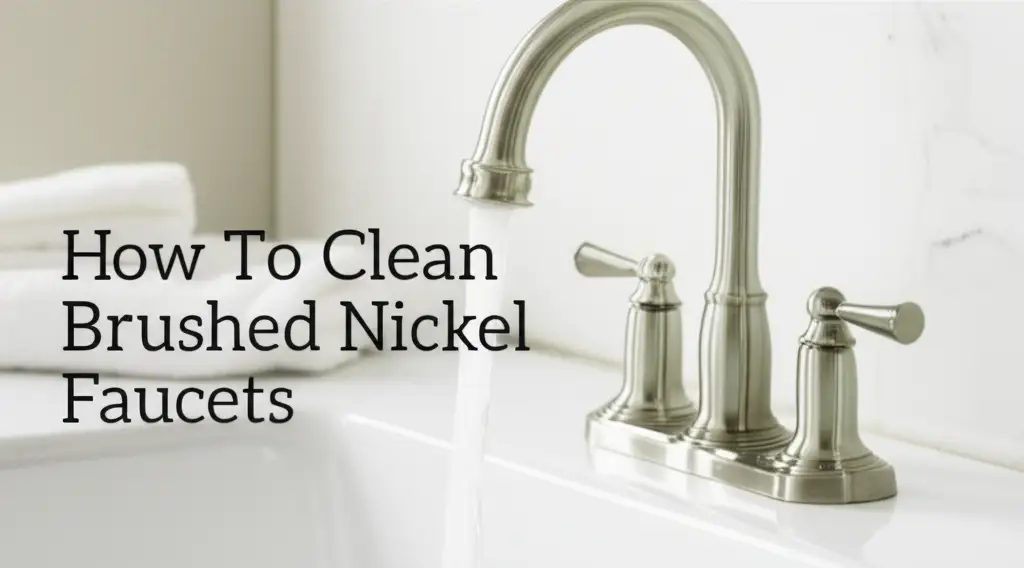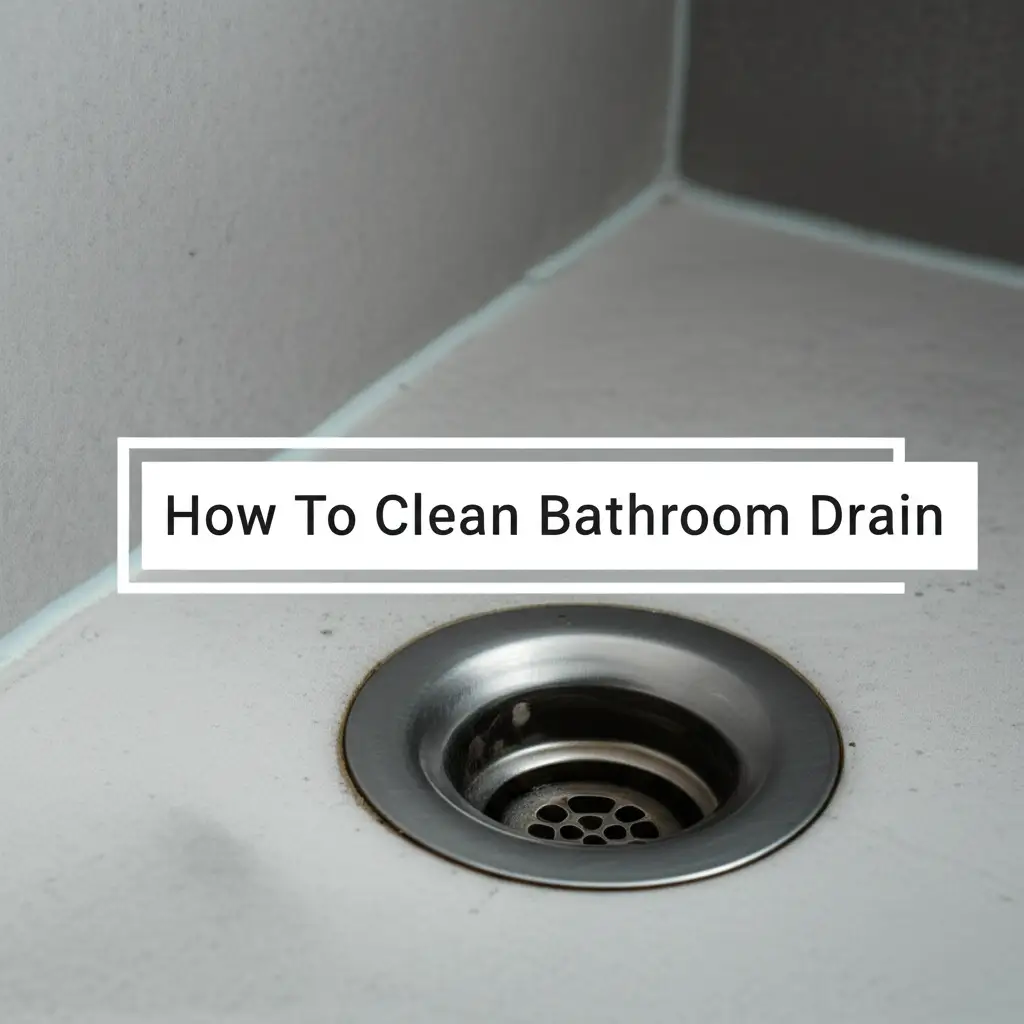· Home Maintenance · 19 min read
How To Clean Brushed Nickel Faucets

Cleaning Brushed Nickel Faucets for Lasting Shine
Brushed nickel faucets add a touch of modern elegance to any bathroom or kitchen. Their matte, textured finish looks sophisticated. However, this beautiful surface can quickly show fingerprints, water spots, and soap scum. Regular cleaning is important to keep them looking their best. Neglecting them can lead to stubborn buildup and discoloration over time.
This guide helps you understand the right way to clean brushed nickel faucets. We will discuss common issues and the best cleaning supplies to use. We will also provide step-by-step instructions for routine care and deep cleaning. You will learn how to maintain their unique appearance. Let us make your brushed nickel fixtures shine again.
Takeaway
- Use soft cloths and mild, non-abrasive cleaners.
- White vinegar is effective for hard water stains.
- Avoid harsh chemicals and abrasive scrubbers.
- Dry faucets thoroughly after each use to prevent water spots.
- Regular, gentle cleaning helps maintain the finish.
Cleaning brushed nickel faucets involves gentle methods and mild solutions. Use a soft cloth with warm water and a small amount of dish soap for daily cleaning. For stubborn hard water spots, a dilute white vinegar solution applied with a soft cloth works best. Always rinse thoroughly and dry the faucet to prevent new spots.
Understanding Brushed Nickel: Why Special Care is Needed
Brushed nickel is a popular choice for home fixtures. It offers a contemporary look and resistance to smudges compared to polished finishes. However, its unique surface needs special cleaning care. The “brushed” appearance comes from small, fine lines etched into the metal. These lines help hide minor imperfections. They also scatter light, giving the faucet its distinctive matte look.
This finish is not as delicate as some people think, but it can be damaged by harsh products. Abrasive cleaners or sponges can scratch the surface. Strong chemicals can strip the protective coating. This makes the metal prone to discoloration. Understanding the material helps you choose the right cleaning method. Proper care preserves its beauty for many years.
The Unique Finish of Brushed Nickel
Brushed nickel is a metal finish, often applied over brass or zinc. Manufacturers create it by brushing the surface with a wire brush. This process creates tiny, parallel lines. These lines give the material its characteristic matte appearance. The finish is designed to be durable and resist corrosion. It also hides fingerprints better than shiny chrome.
The texture of brushed nickel is part of its charm. It feels smooth but has a subtle grain. This grain is what can trap tiny particles of dust, soap, or hard water minerals. Therefore, cleaning methods must respect this texture. We want to remove dirt without harming the finish. Choosing the correct tools and solutions is important for this task.
Common Issues Affecting Brushed Nickel Faucets
Brushed nickel faucets face several common problems. Water spots are perhaps the most frequent issue. Hard water contains minerals like calcium and magnesium. When water evaporates, these minerals remain on the surface. They form cloudy white spots that stand out on the matte finish. Soap scum also builds up in bathrooms. It creates a film that dulls the faucet’s shine.
Fingerprints are less visible than on polished chrome but still appear. Oils from your skin transfer easily to the surface. Over time, these can create a greasy look. Sometimes, cleaning products themselves leave streaks or residue. Rust can also be a problem if water stands on the faucet for too long, especially in areas with high iron content in water. Addressing these issues with the right approach helps keep your faucets pristine.
Essential Supplies for Cleaning Brushed Nickel Faucets
Before you begin cleaning, gather the necessary supplies. Using the right tools and cleaning agents protects your brushed nickel finish. You do not need many items. Most supplies are likely already in your home. Always choose non-abrasive materials. This prevents scratches and preserves the faucet’s appearance.
Having everything ready saves time and makes the process smoother. I always make sure I have a good supply of microfiber cloths. They are gentle and effective. Good preparation is the first step to achieving a sparkling clean faucet.
Safe Cleaning Agents
Choosing the correct cleaning agents is crucial for brushed nickel. You must avoid harsh chemicals. Abrasive cleaners will damage the finish. Here are the best options for safe and effective cleaning:
- Mild Dish Soap: This is excellent for daily cleaning. Mix a few drops with warm water. It removes light grime and fingerprints without harming the finish.
- White Vinegar: White vinegar is your best friend for hard water stains. Its mild acidity dissolves mineral deposits. Dilute it with water for general use. Use it full strength for stubborn spots. Vinegar is a natural, effective cleaner. You can use vinegar for many other cleaning tasks, such as when you clean your shower with vinegar.
- Baking Soda: Create a paste with baking soda and a little water. This gentle abrasive helps remove tough grime and stains. It is mild enough for delicate surfaces.
- Rubbing Alcohol (Isopropyl Alcohol): This works well for grease, oil, and sticky residues. It evaporates quickly and leaves no streaks. Apply it sparingly to a cloth.
- Lemon Juice: Similar to vinegar, lemon juice has mild acidic properties. It can help with light hard water spots and leaves a fresh scent.
Always test any new cleaning solution on an inconspicuous area first. This ensures it does not harm the finish.
Tools for Effective Cleaning
The tools you use are just as important as the cleaning agents. Avoid anything that can scratch the delicate finish of brushed nickel.
- Microfiber Cloths: These are indispensable. Microfiber cloths are soft, absorbent, and non-abrasive. They pick up dirt and water effectively without leaving lint or streaks. I prefer using different colored cloths for different cleaning tasks.
- Soft Sponge: A non-scratch sponge can help apply cleaning solutions. Ensure it has no abrasive scouring pad.
- Soft-Bristled Brush: A toothbrush or a soft nylon brush can reach tight spots. Use it gently around the base and handles of the faucet. These areas often collect grime.
- Cotton Swabs: These are great for very small crevices and detailed cleaning.
- Spray Bottle: A small spray bottle is useful for applying diluted vinegar or soap solution. It allows for even distribution.
Never use steel wool, abrasive scrub pads, or harsh brushes. These tools will scratch the brushed finish. They can cause irreversible damage. Stick to soft materials to protect your investment.
Step-by-Step Guide to Clean Brushed Nickel Faucets
Cleaning your brushed nickel faucets does not have to be a chore. A consistent routine keeps them looking new. This guide breaks down the process into simple steps. We cover everything from daily wipe-downs to deep cleaning for stubborn issues. Following these steps helps you maintain the beauty of your fixtures.
I find that routine maintenance makes deep cleaning much easier. My approach helps prevent major buildup. It keeps my brushed nickel faucets sparkling.
Routine Cleaning for Daily Shine
Regular cleaning prevents grime buildup and water spots. This simple routine takes only a minute or two. It makes a big difference in maintaining the faucet’s appearance.
- Wipe Down Daily: After each use, especially after washing hands or dishes, quickly wipe the faucet. Use a soft, dry microfiber cloth. This removes water droplets before they dry and form spots.
- Gentle Soap Wash (Weekly): Once a week, give the faucet a slightly more thorough cleaning.
- Mix a few drops of mild dish soap with warm water in a small bowl or spray bottle.
- Dampen a soft microfiber cloth with the soapy water.
- Gently wipe down all surfaces of the brushed nickel faucet. Pay attention to the handles and spout.
- Rinse the cloth with clean water and wipe down the faucet again. This removes all soap residue.
- Immediately dry the faucet thoroughly with a separate, clean, dry microfiber cloth. Ensure no water spots are left.
This routine is quick and effective. It keeps your faucets looking fresh.
Addressing Hard Water Stains and Soap Scum
Hard water stains and soap scum are common issues. They require a bit more attention than daily wipe-downs. Here is how to tackle them effectively:
- Prepare a Vinegar Solution: Mix equal parts white vinegar and water in a spray bottle. For very stubborn stains, you can use full-strength white vinegar. For example, when you want to remove mold, you can clean mold with vinegar.
- Apply the Solution: Spray the vinegar solution directly onto the affected areas. Make sure to saturate the hard water spots and soap scum.
- Let it Sit: Allow the vinegar solution to sit on the faucet for 5-10 minutes. This gives the acid time to break down the mineral deposits. For very tough stains, you can soak a cloth in vinegar and wrap it around the faucet for a longer period, up to 30 minutes.
- Gently Scrub: After soaking, use a soft microfiber cloth or a soft-bristled brush. Gently scrub the stained areas. The stains should start to lift away easily.
- Rinse Thoroughly: Rinse the faucet with clean water. Ensure all vinegar residue is gone.
- Dry Completely: Immediately dry the faucet with a clean, dry microfiber cloth. This prevents new water spots from forming. Drying is key to a streak-free finish.
This method is safe and highly effective for most hard water and soap scum issues. You can use similar principles for cleaning brushed gold faucets as well.
Removing Stubborn Grime and Mineral Buildup
Sometimes, routine cleaning is not enough for heavy buildup. For stubborn grime or caked-on mineral deposits, you might need a stronger approach. This process helps restore heavily soiled faucets.
- Baking Soda Paste: Make a paste using baking soda and a small amount of water. It should have the consistency of toothpaste.
- Apply the Paste: Apply the baking soda paste directly to the stubborn grime or mineral buildup.
- Gentle Scrubbing: Use a soft-bristled brush or a soft cloth to gently scrub the area with the paste. The baking soda acts as a mild abrasive. It helps lift and scour away tough deposits without scratching. For very intricate areas, a cotton swab can be helpful.
- Rinse Well: Thoroughly rinse the faucet with clean water. Make sure all traces of the baking soda paste are removed. Any residue can dry to a white film.
- Follow with Vinegar (Optional but Recommended): If mineral deposits persist, follow up with the vinegar solution method described above. The baking soda helps loosen, and the vinegar dissolves remaining minerals.
- Dry Immediately: As always, dry the faucet completely with a clean, dry microfiber cloth.
This combination of baking soda and vinegar is a powerful duo. It tackles even the most stubborn stains safely.
Polishing and Protection
After cleaning, you might want to add a layer of protection. This helps repel water and prevent future spots.
- Buffing for Shine: Once the faucet is completely clean and dry, use a clean, dry microfiber cloth. Gently buff the entire surface. This enhances the natural luster of the brushed nickel.
- Applying a Protective Wax (Optional): Some people choose to apply a very thin layer of car wax or a specialized faucet wax.
- Apply a tiny amount of wax onto a clean, soft cloth.
- Wipe it evenly over the faucet surface.
- Let it dry for a few minutes according to product instructions.
- Buff it off with another clean, dry microfiber cloth. This creates a water-repellent barrier. It makes future cleaning easier. Ensure the wax is safe for metal finishes. Always check product labels.
This final step adds an extra layer of defense. It keeps your brushed nickel looking newer for longer.
Natural Cleaning Solutions for Brushed Nickel
Nature provides some of the best cleaning agents. They are safe for your brushed nickel faucets. These natural options are often as effective as commercial cleaners. They also avoid harsh chemicals. This is better for your home environment and your family. I prefer natural methods whenever possible. They are gentle on surfaces and tough on stains.
White Vinegar: Your Go-To Solution
White vinegar is a cleaning powerhouse. Its mild acetic acid works wonders on mineral deposits. It is perfect for hard water stains on brushed nickel. I keep a spray bottle of diluted vinegar ready for quick touch-ups.
To use vinegar:
- Dilute if needed: For light stains, mix equal parts white vinegar and water. For tough stains, use full-strength vinegar.
- Apply to the surface: Spray the solution directly onto the faucet. Alternatively, soak a cloth in vinegar and drape it over the stained areas.
- Let it work: Allow the vinegar to sit for 5 to 15 minutes. For stubborn mineral buildup, you can let it sit for up to 30 minutes. The acid breaks down calcium and magnesium deposits.
- Wipe and rinse: Use a soft microfiber cloth to wipe away the loosened stains. Rinse the faucet thoroughly with clean water to remove all vinegar residue.
- Dry completely: Always dry the brushed nickel faucet immediately with a clean, dry cloth. This prevents new water spots.
Vinegar also helps sanitize surfaces. It leaves your faucets clean and streak-free. It can also be very useful when you clean mold in your shower.
The Power of Baking Soda Paste
Baking soda is a gentle abrasive that cleans without scratching. It is effective for tackling soap scum and mild grime on brushed nickel. Its alkaline nature helps break down greasy residues.
To make and use baking soda paste:
- Make a paste: In a small bowl, mix a few tablespoons of baking soda with just enough water to form a thick paste. The consistency should be like toothpaste.
- Apply to stained areas: Use your fingers or a soft cloth to apply the paste to areas with soap scum or stubborn grime.
- Gently scrub: With a soft sponge or a clean cloth, gently rub the paste onto the surface. Use small circular motions. The fine particles of baking soda will gently scour away the dirt.
- Rinse thoroughly: Rinse the faucet completely with clean water. Ensure no baking soda residue remains.
- Dry immediately: Wipe the faucet dry with a clean, dry microfiber cloth.
Baking soda paste is an excellent alternative for spots that do not respond to vinegar alone. It provides a gentle scrubbing action.
Lemon Juice for Shine and Freshness
Lemon juice is another natural acidic cleaner. It is similar to white vinegar in its ability to dissolve hard water stains. Plus, it leaves a pleasant, fresh scent.
To use lemon juice:
- Cut a lemon: Cut a fresh lemon in half.
- Direct application: You can rub the cut side of the lemon directly onto hard water spots. For general cleaning, squeeze some juice onto a soft cloth.
- Let it sit: Allow the lemon juice to sit on the faucet for 5-10 minutes.
- Wipe and rinse: Wipe the faucet with a soft cloth to remove the loosened stains. Rinse thoroughly with clean water.
- Dry: Immediately dry the faucet with a clean, dry microfiber cloth.
Lemon juice is a good choice for lighter stains. It adds a natural citrus fragrance to your cleaning routine. Remember that even natural acids like lemon juice can be strong. Always rinse and dry completely to protect your brushed nickel finish.
What to Avoid When Cleaning Brushed Nickel
Knowing what not to use on your brushed nickel faucets is as important as knowing what to use. Using the wrong products or tools can cause irreversible damage. This includes scratching the finish or causing discoloration. Protecting your investment means being careful with your cleaning choices. I learned this the hard way with a previous fixture. Always double-check your cleaning supplies.
Harsh Cleaners and Their Dangers
Many common household cleaners are too strong for brushed nickel. They can strip the finish or cause permanent damage. Always read product labels carefully.
Avoid cleaners containing:
- Ammonia: This chemical can react with the nickel finish. It may cause discoloration or dullness over time.
- Bleach (Chlorine Bleach): Bleach is corrosive to many metals, including nickel. It can cause pitting, staining, or a dull, faded appearance.
- Abrasive Chemicals: Powders, scrubbing creams, or cleaners with harsh grit will scratch the brushed surface. This removes the characteristic finish.
- Strong Acids (e.g., rust removers, toilet bowl cleaners): These products are highly corrosive. They will instantly damage and strip the brushed nickel finish. They can etch the metal.
- Petroleum-based cleaners: These can leave a greasy residue that is difficult to remove. They may also dull the finish.
Using these harsh cleaners negates the protective properties of the brushed nickel finish. Stick to mild, pH-neutral options or natural solutions.
Abrasive Tools to Steer Clear Of
Just as important as avoiding harsh chemicals is avoiding abrasive tools. Even with a gentle cleaner, a rough tool can ruin your faucet.
Do not use:
- Steel Wool Pads: These are highly abrasive. They will scratch and permanently damage the brushed nickel finish.
- Scouring Pads: The rough side of most kitchen sponges contains abrasive particles. These will leave scratches.
- Stiff Brushes with Plastic Bristles: While some soft brushes are okay, stiff plastic bristles can be too harsh. They may scratch the surface, especially if used with too much pressure.
- Rough Cloths or Paper Towels: Some paper towels can be surprisingly abrasive. They can leave micro-scratches. Always opt for soft materials.
Even if a product claims to be “non-scratch,” test it first. A small, hidden area is best for a trial. Gentle cleaning with soft materials is key to preserving your brushed nickel.
Maintaining the Luster: Tips for Long-Term Faucet Care
Keeping your brushed nickel faucets beautiful is an ongoing process. It extends beyond just cleaning. Incorporating preventative measures into your routine makes a big difference. These tips help maintain the unique luster of your fixtures. They also reduce the frequency of deep cleaning. I always try to practice these habits myself. Prevention is easier than cure.
Preventing Water Spots and Fingerprints
Water spots are the most common enemy of brushed nickel. Preventing them is simple. It saves a lot of cleaning effort.
- Wipe Dry After Every Use: This is the golden rule. Keep a soft, dry microfiber cloth near the sink. After washing hands, doing dishes, or showering, quickly wipe down the faucet. This removes water droplets before they can dry and leave mineral deposits.
- Use Soft Water (If Possible): If you live in an area with very hard water, consider installing a water softener for your home. This reduces mineral content. It prevents hard water spots on all fixtures and appliances.
- Avoid Splashing: Be mindful when using the faucet. Try to minimize splashing water onto the fixture’s surface. A little care goes a long way.
- Clean Hands: Encourage family members to wash their hands before touching the faucet handles, especially if their hands are greasy or dirty.
These simple habits drastically reduce water spot and fingerprint issues.
Regular Drying Habits
Drying is often overlooked but extremely important. It is the single most effective preventative measure for water spots.
- Dedicated Drying Cloth: Have a specific microfiber cloth designated for drying your faucets. Keep it clean and dry.
- Thoroughness: Do not just wipe quickly. Ensure every part of the faucet, including the spout, base, and handles, is completely dry. Pay attention to crevices where water can pool.
- Educate Family Members: Teach everyone in the household the importance of drying the faucets after use. This shared responsibility helps maintain the finish.
Making a habit of drying prevents mineral buildup. It keeps your brushed nickel looking consistently new.
Protective Waxes and Sealants
For an extra layer of protection, consider using a protective wax or sealant. These products create a barrier on the faucet’s surface. This barrier repels water and makes it harder for dirt and minerals to stick.
- Car Wax: A high-quality car wax (specifically carnauba wax) can be effective. It offers a protective layer and a nice shine.
- Ensure the faucet is perfectly clean and dry.
- Apply a very thin coat of wax with a soft applicator pad or cloth.
- Let it haze over, then buff it off gently with a clean microfiber cloth.
- Specialty Faucet Waxes/Sealants: Some brands offer specific waxes or sealants for plumbing fixtures. These are designed to be water-resistant and non-damaging.
- Follow the product’s instructions carefully.
- These often provide longer-lasting protection.
Apply these waxes every few months, or as needed. Always test on an inconspicuous area first. This ensures no adverse reaction with your faucet’s finish. A protective layer makes cleaning easier and extends the life of your brushed nickel.
Troubleshooting Common Brushed Nickel Faucet Problems
Even with the best care, brushed nickel faucets can sometimes develop specific issues. These might include rust spots, discoloration, or persistent streaks. Knowing how to address these problems can restore your faucet’s appearance. Do not panic if you see a new spot. Most issues have a solution.
Dealing with Rust Spots
Rust spots on brushed nickel are usually not from the faucet itself. They often come from external sources. For example, iron particles in water, or metal cans left on the sink rim. These particles rust and transfer onto the faucet.
- Identify the Source: First, find what caused the rust. Remove any metal items that might be rusting near the faucet.
- Gentle Scrub: For light rust, try a paste of baking soda and a few drops of water. Apply it to the rust spot. Use a soft cloth or a soft-bristled toothbrush to gently scrub the area. The mild abrasive action helps lift the rust.
- Vinegar Soak: If the rust persists, soak a cotton ball or a small piece of paper towel in white vinegar. Place it directly over the rust spot. Let it sit for 15-30 minutes. The acid helps dissolve the rust.
- Wipe and Rinse: Gently wipe away the rust and vinegar with a soft cloth. Rinse the faucet thoroughly with clean water.
- Dry Completely: Dry the faucet immediately with a clean, dry microfiber cloth.
Avoid harsh rust removers. These can damage the brushed nickel finish. Persistence with gentle methods is key.
Restoring Discolored Finishes
Discoloration on brushed nickel is less common with proper care. It can happen from harsh chemical exposure or prolonged neglect. The finish might look dull, faded, or have patchy dark spots.
- Identify the Cause: Try to recall if any strong cleaners were used on the faucet. Chemical reactions are a primary cause of discoloration.
- Deep Clean with Natural Solutions:
- Start with a thorough cleaning using the white vinegar method. This removes any lingering hard water stains or residue that might be contributing to the dullness.
- Follow up with a baking soda paste. Gently apply it over the discolored areas. Scrub very gently with a soft cloth. This might help to subtly buff and even out the finish.
- Specialty Polish: If natural methods do not work, consider a specialty brushed nickel cleaner and polish. These products are formulated for the specific finish.
- Choose a non-abrasive, pH-neutral product.
- Follow the manufacturer’s instructions precisely.
- Test on an inconspicuous area first.
- Professional Help: For severe or widespread discoloration, professional re-finishing might be the only option. This is rare for common household use.
Prevention is the best strategy for discoloration. Always use recommended cleaning methods. Promptly address any spills of harsh chemicals.
FAQ Section
Q1: How often should I clean brushed nickel faucets?
You should wipe brushed nickel faucets dry after every use to prevent water spots. Perform a mild soap and water cleaning weekly. Deep clean with vinegar or baking soda as needed for hard water stains or grime, typically once a month or every few weeks depending on usage and water hardness.
Q2: Can I use commercial cleaners on brushed nickel?
Most commercial bathroom cleaners are too harsh for brushed nickel. Many contain abrasive chemicals, ammonia, or bleach which can damage the finish. It is best to avoid them. Stick to mild dish soap, white vinegar, or baking soda for safe and effective cleaning. Always read labels.
- brushed nickel cleaning
- faucet care
- bathroom cleaning




